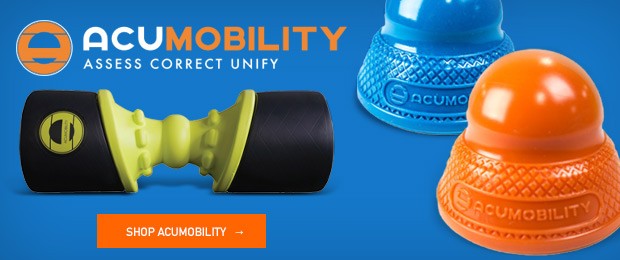
If you train hard, you'd better plan to recover just as hard. Clint Darden knows exactly how to do both. Several weeks ago he received a question about how to speed up the recovery part of the equation:
"What recovery tools do you use the most?"
Clint is the guy to come to for this, because he uses a lot of recovery tools. Some tools he uses more often than others and some tools he likes better than others, but it's important to know that there is a difference between the ones he uses most often and the ones he likes best. Among many tools, for similar purposes he has used a TimTam deep tissue massage device and a car buffer (the problem with both of these being that they make a lot of noise, which for Clint is a problem with a sleeping wife and kids). He has also used many rolling and self-myofascial release tools, compression floss bands, and more. Of all these tools he has experience with, these are the three he uses most often:
Acumobility Mobility Balls
These devices are essentially rubber balls with a flat surface on one end. Clint typically uses these on the floor—for him usually concrete, tile, or ceramic—and says that one big advantage of these over tennis or lacrosse balls is that they stick on the floor and don't roll around, making it much easier to target the areas that need treatment. You can also use the Acumobility Mobility Balls against a wall without fear of leaving a mark or damaging paint. Clint also uses these under his hamstring when he's sitting or working and says they're great behind the neck, on the upper back, through the lats, and around the hips. Very lightweight and easy to fit in a bag, they're also great for travel.
E-Stim Machines
Clint has used several of these devices without significant difference between them. Though there are certainly professional ways to use this device, Clint's approach is simple: put the pads on or around the area that hurts and turn on the machine. Most e-stim devices have multiple settings and different patterns, but Clint hasn't noticed much of a difference in results from various settings. When using these, you will feel the muscle twitch and jump as the device stimulates it. This device is also easy to travel with and can be used at almost any time of day.
Foam Rollers
Most of Clint's foam rolling is done at home, but he keeps many types of foam rollers both at home and at the gym. There are a lot of different types and intensities, from traditional foam rollers to PVC pipe to studded metal, and Clint likes them all. Though many people may dislike foam rolling and tell you not to do it, it's incredibly cheap, incredibly easy to do, and can really help you work on sore and painful areas. One of the best things about this recovery tool is that you can find a foam roller almost anywhere for very cheap, which means when you travel, you can find one at almost any sports store and use it while you're away from home.










2 Comments